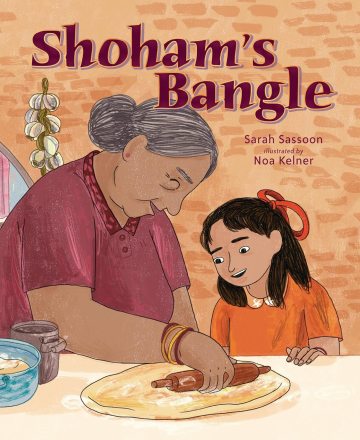Sarah Sassoon
Nor Kelner, Illustrator
SHOHAM'S BANGLE
KAR-BEN Publishing, 2022. ISBN: 9781728439020
Reviewed by Rochelle Strauss1
Shoham, a young girl, lives in Baghdad Iraq, with her parents, four brothers, and grandparents. She has a close, loving relationship with her Nana (grandmother) Aziza. They share many household activities; they prepare meals, bake and pick the figs in the garden. Shoham wears one bangle and her Nana many that jingle when chopping food and cutting out the perfect shape for date cookies. It glitters in the sun when they pick figs. The bangles are intrinsic to the rhythm and comfort of the daily routines of home.
One morning, Shoham’s mother tells her they are leaving for Israel. She takes Shoham’s bangle off, explaining that the Iraqi government will not allow them to take their jewelry. She reassures her, that as long as the family is together, everything will be all right. Shoham knows her father prays and sings about Israel, but she does not ask why they are leaving. Instead, she seeks out her Nana, and the reassurance of her jingling bangles. Nana, who is in the kitchen baking pita bread for the journey, doesn’t have her bangles either. As she gives Shoham the bag with the pita, with the instruction to hold it tight on the trip to Israel, she also reaffirms that they will be all right staying together.
The family is allowed one suitcase for all the possessions they can take. They join hundreds of families at the airport. After inspections they are allowed to board and Shoham is relieved that she is still clutching the bag of pita.
After landing in Israel, they are taken to a temporary settlement camp. Nana Aziza compares the pita to the matzah of the Israelites when they escaped Egypt. Shoham, eager to finally eat the pita, bites into something hard. It is her bangle baked into the pita. When Nana puts it on Shoham’s wrist, she says it will be a remembrance of where they came from. Shoham is also comforted knowing that with each twist on her wrist, that the bangle will be a part of making new memories, as well as holding on to the old ones.
The story is written for the reading levels of ages five through nine. Shoham begins the story, describing, in brief sentences, how the bangles are part of their simple, daily routines. Once she takes it off, the story is about change, as she leaves behind the home and home-life of Baghdad. When she doesn’t ask why they are leaving, we sense she has taken to heart the reassurances of their well-being by her family. Their resilience through all the changes strengthens her, too. She bravely holds onto the pita bag, not knowing its actual value.
What’s described next includes the packing of the suitcase, families gathering at the airport, baggage inspections, getting on the crowded plane, and finally, landing in Israel. These events have taken them away from what’s comfortable and familiar. Noa Kelner's naturalistic, watercolor illustrations visualize for us this journey from the spacious family home and garden, to the crowded, enclosed airport among hundreds of others, and then into the crowded plane. Her muted colors and black pen outlines, capture the expressions of fear, uncertainty, and hope on the faces of these Iraqi Jews. Once in Israel, the sparse landscape is in contrast to the close-set roofs of old Baghdad. Yet, in this new environment, Shoham is once again doing ordinary, homelike activities, especially making cookie shapes with her bangle, cooking with her Nana.
The only family relationship developed is between Shoham and Nana Aziza. They have the same loving, smiling faces whether in Iraq or Israel. The reader is heartened that the family will endure despite hardship. The reason they are leaving Iraq is not explained. We can identify them as Jewish, by the reference to the father’s prayers, the picture of the Temple in Jerusalem, and the grandfather's kippah. The emphasis of the story is on the family and relationships and the love and togetherness that got them through terrible times.
The author, Sarah Sassoon, based this story on her own Nana Aziza's experience leaving Iraq in 1951. Operation Ezra and Nehemiah airlifted 120,000 Iraqi Jews to Israel. This background information is provided in the author’s notes at the end of the book. Questions from readers will have to be answered elsewhere.
Jews were forced into exile to save their lives and livelihoods: by foot, by cart, by horse, by ship, by train, by car, by plane, and other different modes of transportation over the centuries. This refugee story concludes with Shoham and her Nana adapting to their new home. Each twist of her bangle helps her cope with each new situation. The last twist at night is when she remembers her home by the Tigris and her fig tree. The final illustration shows Shoham in her bed, the fig tree pictured beside her; it is a simple, touching expression of the refugee's flight and loss as an enduring memory.
1 Rochelle Strauss is a retired librarian, Brooklyn Public Library, New York
Copyright by Sephardic Horizons, all rights reserved. ISSN Number 2158-1800

